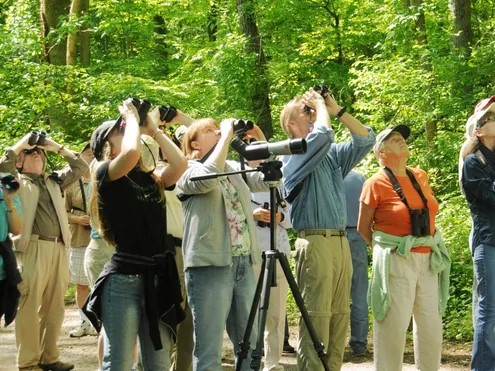Our First Saturday Bird Outings, created as part of our commitment to the Lane Audubon…
Audubon Statement on the Occupation of Malheur National Wildlife Refuge
January 3, 2016: Malheur National Wildlife Refuge was established in 1908 by President Theodore Roosevelt to protect the vast populations of waterbirds that were being decimated by wanton killing by the plume trade. The 188,000 acre refuge represents some of the most important bird habitat on the Pacific Flyway. It is one of the crown jewels of the National Wildlife Refuge System and belongs to all Americans. In 2013, the Refuge adopted a long-term management plan developed through an inclusive collaborative process that brought together the local community, tribes, conservation groups, state and federal agencies, and other stakeholders. These stakeholders have continued to work together to implement this strategy which includes one of the biggest wetland restoration efforts ever undertaken.
The occupation of Malheur by armed, out of state militia groups puts one of America’s most important wildlife refuges at risk. It violates the most basic principles of the Public Trust Doctrine and holds hostage public lands and public resources to serve the very narrow political agenda of the occupiers. The occupiers have used the flimsiest of pretexts to justify their actions-the conviction of two local ranchers in a case involving arson and poaching on public lands. Notably, neither the local community nor the individuals convicted have requested or endorsed the occupation or the assistance of militia groups.
Audubon fought 100 years ago to protect this incredible place. The powerful images taken by Oregon Audubon founder, William Finley, of Malheur’s incredible bird populations and the wanton killing that was being
inflicted upon them, caused President Theodore Roosevelt to make Malheur one of the first wildlife refuges in the Western United States. Audubon Chapters across Oregon and Washington, from our coasts, valleys, mountains and deserts, rural and urban, call upon the local, state and federal authorities to once again protect this incredible place for the amazing wildlife that live there and to preserve this natural heritage for current and future generations. Audubon greatly appreciates the outstanding federal employees that staff the refuge, as well as members of the local community who have rejected this illegal occupation. We hope for a safe, expeditious end to this armed occupation. The perpetrators of this armed occupation should be prosecuted. It is time for myriad local and non-local stakeholders to continue to work together to restore Malheur in ways that are supportive of both the local ecology and the local economy–the occupiers are serving nobody’s interests except their own.
The real shame would be if Malheur came to be seen as a flashpoint for controversy. In fact it should be seen as a tremendous example of true collaboration and consensus building—a place where myriad diverse interests came together, worked hard and developed a common agenda to support both the local ecology and the local economy. On a landscape rife with tremendous challenges, we need to redouble efforts on a place where consensus and collaboration is being accomplished. This should be a call to action for the community, non-governmental stakeholders, and local, state and federal agencies to invest deeply in the Malheur effort. It is a critically important opportunity and it needs to succeed.
Ken Hashagen, President, East Cascades Audubon Society
Bob Sallinger, Conservation Director, Portland Audubon Society
Linda Kreisman, President, Rogue Valley Audubon Society
Paul Engelmeyer, Manager, Audubon Ten Mile Creek Sanctuary
Ann Vileisis, President, Kalmiopsis Audubon Society
Diana Wales, President, Umqua Valley Audubon Society
Jim Fairchild, Conservation Chair, Corvallis Audubon Society
David Harrison, Conservation Chair, Salem Audubon Society
Susan Bennett, Conservation Chair, Whidbey Island Audubon Society
Dan Streiffert, Conservation Chair, Rainier Audubon Society
Krystal Kyer, Executive Director, Tahoma Audubon Society
Tom Gauron, President, Kittitas Audubon Society
Tim Manns, Conservation Chair, Skaggit Audubon Society
George Exum, President, Willapa Hills Audubon Society
Susan Bush, President, Siskiyou Audubon Society
Harvey Schubothe, President, Cape Arago Audubon Society
Maeve Sowles, Lane County Audubon Society
Lori Nelson, President, Lower Columbia Basin Audubon Society
Deb Nickerson, President, Black Hills Audubon Society
Barb Jensen, president, San Juan Island Audubon Society
Chris Howard, Conservation Chair, Blue Mountain Audubon Society
Allen Gibbs, Conservation Chair, Pilchuck Audubon Society
Rick Jahnke, president, Admiralty Audubon Society
Ken Wiersema, President, Olympic Peninsula Audubon Society
The following vision was adopted for the Malheur National Wildlife Refuge by a diverse array of stakeholders including members of the local community in 2013.
Together with our surrounding community, partners, friends, staff, and all those who cherish this unique place where desert and water meet.
Malheur National Wildlife Refuge commits to care for, conserve, and enhance the health of the Malheur Lake, Blitzen Valley, and Double-O units, including the playas, dunes, marshes, rivers, meadows, and ponds that are
all part of this landscape.
We will observe nature and manage in harmony with ecological forces, while recognizing and maintaining the Refuge as a key anchor for migratory and breeding waterfowl, waterbirds, shorebirds, songbirds, and raptors.
We will work diligently to improve the health of the land and water, reducing the destructive impact of carp and other invasive species, addressing imbalances in floodplain function, and restoring the original abundance of fish and wildlife for which Malheur is famous.
We will celebrate and welcome our visitors, noting and protecting the features that draw people again and again-the expansive landscape, the plenitude and diversity of wildlife, and the signs of a timeless history.
We will allow and enhance opportunities to experience abundance, solitude, and renewal, for people birding, fishing, hunting, and learning on the Refuge. In respect to our ancestors and their fortitude, we will carefully
preserve the legacies they left behind on this land.
Collaboration with our neighbors, partners, and friends will be a critical cornerstone in our day to day work; we recognize that nature crosses our boundaries and we can be successful only in partnership. We recognize that our activities are inextricably linked to the health of the local economy. We commit to environmental stewardship and sustainable management. We commit to learn from our efforts, successes, and failures; to be humble about what we know; and to continuously strive for greater understanding in our stewardship of this remarkable place.
____________
For more information on Audubon’s connection with Malheur, please contact your local chapter.
For updated information about Malheur visit the “Restore Malheur” facebook page online



